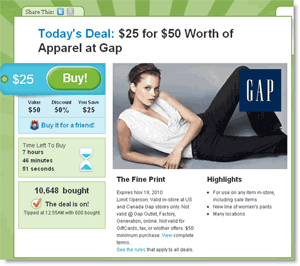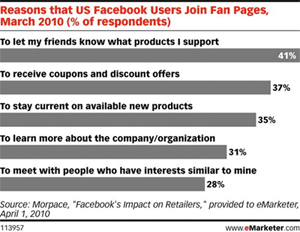Is a Social Coupon your ticket to success? close

Ever heard of Groupon?
If you haven’t you soon will. Groupon offers one discount coupon deal per day in cities around the world. The trick is that the deal only kicks in if enough people buy it. The site heavily utilises major social networks to help and incentivise bargain hunters to share the good news with their friends in the hope that the deal is triggered - "collective buying power".
Since launching in late 2008 it has taken off in the US and has inspired a large number of lookalike companies and campaigns in the space as well as creating a market for unredeemed coupon trades. Speculation has recently been mounting that a big number takeover bid from Yahoo, Google, Amazon or eBay is imminent.
The business is also growing internationally through acquisition and natural growth and recently ran its first nationwide campaign for Gap across America.

But was it successful or not?
The $11 million Gap day was timed to coincide with the back-to-school rush. 445,000 shoppers bought a $25 voucher for $50 worth of Gap clothing, a move that sparked a huge amount of buzz online (well, before they decided to muck about with their logo).
This buzz would have boosted Groupon’s subscriber base enormously as well as make them a decent amount of money, Groupon normally take 50% of the coupon price. However marketers are divided over the value of the campaign.
"All in favour say I"
The average purchase of a Gap customer once in the store is likely to be a lot higher than $50, especially around the back-to-school period when the majority of stock is at full-price.
The offer expires after 3 months. After that, Groupon buyers can exchange their voucher for a $25 gift card instead of the $50 credit. Those that do not redeem at all are simply lining the pockets of Groupon and Gap.
Gap may have negotiated a better split than the normal 50% due to the value they bring to Groupon in terms of new subscribers. Gap running on Groupon also enhances their image considerably and the word of mouth spread was highly effective. There is also a brand building element as users that don’t buy are still hearing about the business and its latest messaging.
Marketers have compared this multi-million dollar marketing spend to the effectiveness of a magazine or TV ad which instills less reason for the customer to come in through the door. A Groupon customer has already spent the money, valuable cash in the bank until the customer redeems it, and a far greater incentive to follow up.
"I just don’t buy it"
The economics don’t work for most businesses. It’s nearly impossible to make a profit when you are giving away 75% of the initial purchase (50% to the consumer and 25% to Groupon) unless your new customers return regularly. In effect the $11 million in revenue is also potentially $11 million in losses, not taking anyone else’s cut into account.
“Breakage” - the theory of a certain percentage of people forgetting to redeem is not a stable business model. Groupon also sends reminders to its users near the expiration date and remember the user has already purchased, they are likely to redeem!
It caters to the psychology of the bargain hunter who may have never had any intention of shopping at Gap except for this one offer. Arguably they are now only happy to shop at Gap at this value level and no higher. Assuming you need repeat purchases or large basket sizes for the campaign to make sense does this really target the right consumer mindset? Effectively this is a traffic buying exercise resulting in fickle new customers, loyal to deals, not the brand.
This is not the start of a beautiful relationship. Promotions are supposed to help you reach new audiences and develop rapport. In this case the giver of the discount is Groupon, not Gap. The loyalty is not really to the one suffering the margin shortfall.
You are at the mercy of the 50% off culture that has arisen on Groupon. Comparatively a 15% or 25% offer would look stingy but not every business has the same margins that they can afford to play with.
So should we do it?
I have put a stronger case for reasons not to commence a Social Coupon campaign because I think the reasons in favour are fairly obvious. A recent study from Rice University concluded that 66% of the 150 merchants interviewed found Groupon profitable, 32% making no money. In total 40% said they would not participate again.
So, like a proper History graduate I am going to say “Yes, Groupon is worth investigating, but…”
Here are a few tips:
- Do your numbers – there are a huge amount of financial factors to be considered when putting the case for Social Coupons forward. It’s not a straight forward algorithm and you need to be honest with yourself about the stickiness of your full price proposition.
- Quantity does not guarantee profit and in fact could even sink you! Be prepared with a bucket when Groupon turns the tap on - they don't cap the deal at x number of sales, build that into your equation.
- Make the execution of your offer watertight – this is going to cost you and the experience a new Groupon customer gets is crucial. Your entire client facing staff need to be up to speed on the deal and also well trained in upselling or ensuring repeat business.
- Make the terms of your Groupon deal totally clear to your customers - you want them coming back but not at a 50% loss to you each time.
- Beware that you can’t necessarily determine the day your Groupon runs. You need to be careful when negotiating it around a time of year that ideally suits your business. For example a gym would be targeting New Year when health and fitness is most on the mind.
- Groupon users are mostly young. 68% are aged 18 to 34 and they are particularly strong on certain demographic groups such as females. Make sure their audience overlaps with yours!
Some final thoughts on Social Shopping
Typically brands that gain the greatest purchase results through Social Media tend to go one of two ways - either through offering coupons or discounts, or by making noise during sales or special event periods. A survey by Morpace found that 37% of Facebook users joined fan pages for special offers.

eMarketer senior analyst Debra Aho Williamson says, "Coupons remain a leading driver of brand interactions in social networks. At the same time, they can be one of the trickiest social media tactics to pull off. The discount offer must print or download easily and must work as promised. And the retail store or distribution channel must be prepared for demand."
Is there a less scary way?
Maybe you should consider a location based promotion (like Starbucks and L’Oreal) or checkin discount instead? Gap did that as well! The penetration is not quite there yet but Facebook Places is going to change that. The quality of customer is higher and it oozes user evangelism, which is what you are ultimately after.
You can read more about it here. I’m off for some discount booze and food down my local pub.